I’ll Sit at the Counter: A Love Letter to Philadelphia’s Lingering Luncheonettes
Diners at Comfort & Floyd, a neighborhood luncheonette in Passyunk Square
“We’re next to a dead-end street, on the other side of the railroad tracks. Folks don’t find out about us by driving by. It’s word of mouth–it’s families.”
Words By Erica Vanstone with photos by kat veri
Philadelphia is a city of neighborhoods; a phrase I did not coin, but a truth I know in my bones. Few places display this as succinctly and eloquently as the luncheonette. Larger than a corner deli, more compact and cozy than a diner, the luncheonette is an unpretentious, diverse, and delicious slice of life from each block–each a micro-universe unto itself.
Luncheonettes offer hyper-local flavor with counter seating, served up with news and pseudo-news–depending on who’s serving that day. Open early and closed early, at the luncheonette, breakfast and lunch are the stars.
A connoisseur of both, I, for one, am here for it.
On Somerset and Salmon Streets in Port Richmond, I push the already-fogged glass door open and walk into Kitty’s Luncheonette. For an unseasonably warm Tuesday morning in early January, it’s busy. The smells and sounds of a Lower Northeast buzzing with the hum of a second-straight Eagles loss welcome me, as does the heady aroma of coffee and pancakes.
Kitty’s Luncheonette, Port Richmond
“We’re next to a dead-end street, on the other side of the railroad tracks. Folks don’t find out about us by driving by. It’s word of mouth–it’s families.”
Glancing around the unassuming front room, I catch sight of a free pair of seats at the teal formica counter–a counter boasting a handful of round chrome and blue-green stools. But I know this is the best seat in the house. It offers “dinner and a show” as my New York relatives would say; a window to the heart of this simple dragon, a view of the grill.
That, and a word or two with short order cook Jesse Diamond who recalls with a smirk the first order he made me over a year ago, a muffin toasted on the griddle. The steam from the onions cooking off in the pile of crisped home fries underscores this feeling–the reason I love luncheonettes and diners: They are temples of socialization, of straightforwardness.
Folks from faded black and white photographs look on from the walls as my 15 year-old son and I twirl into two of the stools. One of the onlookers from the historic snapshots is “Ratz” Yanette, founder and original cook at Kitty’s; his photo takes up the most real estate on the wall and rightly so. His son, John, faithfully runs the place under his watchful eye.
Kitty’s server hands my son and I double-sided white menus, laminated with missing corners. But we already know what we’re having–like most of the locals, we’re creatures of habit. I order an omelet with mushrooms, spinach, and Swiss; the boy eyes the rows of pancakes in progress on the griddle and opts for ones with chocolate chips.
“Oh, and rye toast please,” I say over the steam from my mug of black coffee. Rye toast feels like home, too, a favorite of my maternal grandfather. The tang of the rye, with a scratched smear of salted butter, tastes like a childhood I perhaps frequently over-romanticize but celebrate nonetheless. For those of us who grew up in houses with active kitchens, the feeling is welcoming and familiar. Like me, other locals come to Kitty’s for the news of the week, the happenings of the block, and a meal that’s made right in front of them from scratch.
“My parents opened the place in 1953,” says John Yanette, owner and Restaurant School-trained chef. Or a time his eldest customers refer to as “after the war;” as in, World War II. His father, “Ratz” Yanette, ran the place until his untimely passing in 1988, when his wife Kitty, took on the business herself–a single mother with kids to raise.
“It started with soups, fresh soups,” he says. “My mother made soups the core of her business and it just took off.” Nowadays, Yanette has a different signature dish Kitty’s is known for. “Best pancakes in the city,” he says, deadpan.
I don’t tell him yet that my son agrees wholeheartedly. Instead, I press Yanette on Kitty’s recipe for longevity, and he has a quick answer.
“We’re next to a dead-end street, on the other side of the railroad tracks,” Yanette quips, pointing out to the Conrail line on the other side of Somerset. “Folks don’t find out about us by driving by. It’s word of mouth–it’s families.”
For over half a century, Kitty’s has been owned and operated by the Yanette family. Port Richmond still boasts many older businesses like his that are primarily family-run, which means they’ve been built and designed around working parents. You’ll find few with hours that cater to the customer; instead most wrap themselves around leisurely holidays and summer vacations–often closing for weeks at a time while owners and their families head down the Shore.
During the years his mother ran Kitty’s, Yanette worked in kitchens throughout the region, including in Bucks County and Cape May. I ask Yanette why he thinks the luncheonette has disappeared in modern times.
“Most of these places were passed down from generations, like mine,” he says from behind a pot of thick, steaming turkey gravy. Then, he shrugs. “Times have changed–kids don’t want to run their parents’ luncheonettes.”
“We’re blue collar,” adds Yanette. “We’re not on Uber Eats or Grubhub–none of that stuff. We’re cash only; straight up takeout or come sit.” A fact I relish in as I thank Jessie, finish my coffee, and pay for the check.
Yanette’s assertions around the generational divides no doubt has had its impact on the survival of the luncheonette and its gradual decline in Philadelphia, specifically. Though in modern times, they’ve been pushed to the brink of extinction by an on-demand food industry, gentrification, and most recently COVID-19, luncheonettes themselves were originally born of convenience over a century ago.
Birthed as the lunch counter by F.W. Woolworth at the turn of the last century–an empire rooted, coincidentally, by the first successful store just down the road in Lancaster, Pennsylvania–the luncheonette began as an inexpensive attraction for shoppers. And more intentionally, as a way to entice folks looking for a quick meal while buying other things.
Over time, they also took on a key role in civil rights.
Hundreds of miles away in North Carolina, four Black students from Greensboro’s Agricultural and Technical–who came to be known as the Greensboro Four–chose the humble lunch counter as a place to stage a sit-in against segregation on February 1, 1960.
“For the downtown Greensboro Woolworth’s, the lunch counter is the largest single money-maker…downtown is deteriorating, and there are few places to eat, and Woolworth’s is a convenient and fairly inexpensive place to eat.” Miles Wolff’s Lunch at the Five and Ten (Ivan R. Dee, 1970) helps explain why the lunch counter became the battleground for segregation: economics and volume.
The success of these sit-ins in exposing racism inspired the LGBTQ community a few short years later in Center City Philadelphia, when Dewey’s lunch counter became the unlikely scene of several arrests, followed by a number of sit-ins. The Dewey’s in question later became the iconic and now-defunct Little Pete’s on 17th Street.
52nd Street, West Philadelphia, 1964, photograph by Denise Scott Brown
“The Dewey’s on 13th was more friendly to gay students,” shares Natalie Pomilio, author of This Used to be Philadelphia (Reedy Press, 2021). “In April of 1965, the management at Dewey’s at 17th and Latimer started telling servers not to take orders from LGBTQ students.” This sparked a sit-in, after which Pompilio says, “more than 150 customers were denied service in the days that followed, so there were more sit-ins.” Following arrests and unwanted media attention, the Dewey’s on 17th relented and ceased discriminatory service practices.
Another win for civil rights at the unassuming luncheonette.
Speaking of wins, you cannot keep hot grits waiting if you aim to eat them successfully.
Mount Airy Breakfast and Lunch, Mt. Airy
“My mom’s philosophy is she doesn’t do short cuts. Her way of doing things is labor intensive, but it does ascertain freshness.”
On a frigid mid-January morning at Mount Airy Breakfast and Lunch on Germantown Avenue I know this to be true as I watch our server hand a bottle of hot sauce to an expectant diner, poised readily over his freshly made grits. Mount Airy Breakfast and Lunch holds the promise of not just piping, velvety grits, but also its more sensual counterpart, cheese grits.
And I am a fan.
Still, I am also a potato girl, and the hash browns with peppers and onions wins over as the side of choice next to my spinach and feta omelet.
Diners at Mount Airy can sit at the lengthy counter or choose a seat from a handful of oblong tables. The dining room is family style, which means you can find yourself scarfing omelets down the table from strangers–a vibe I find unexpectedly welcome in a post-COVID era.

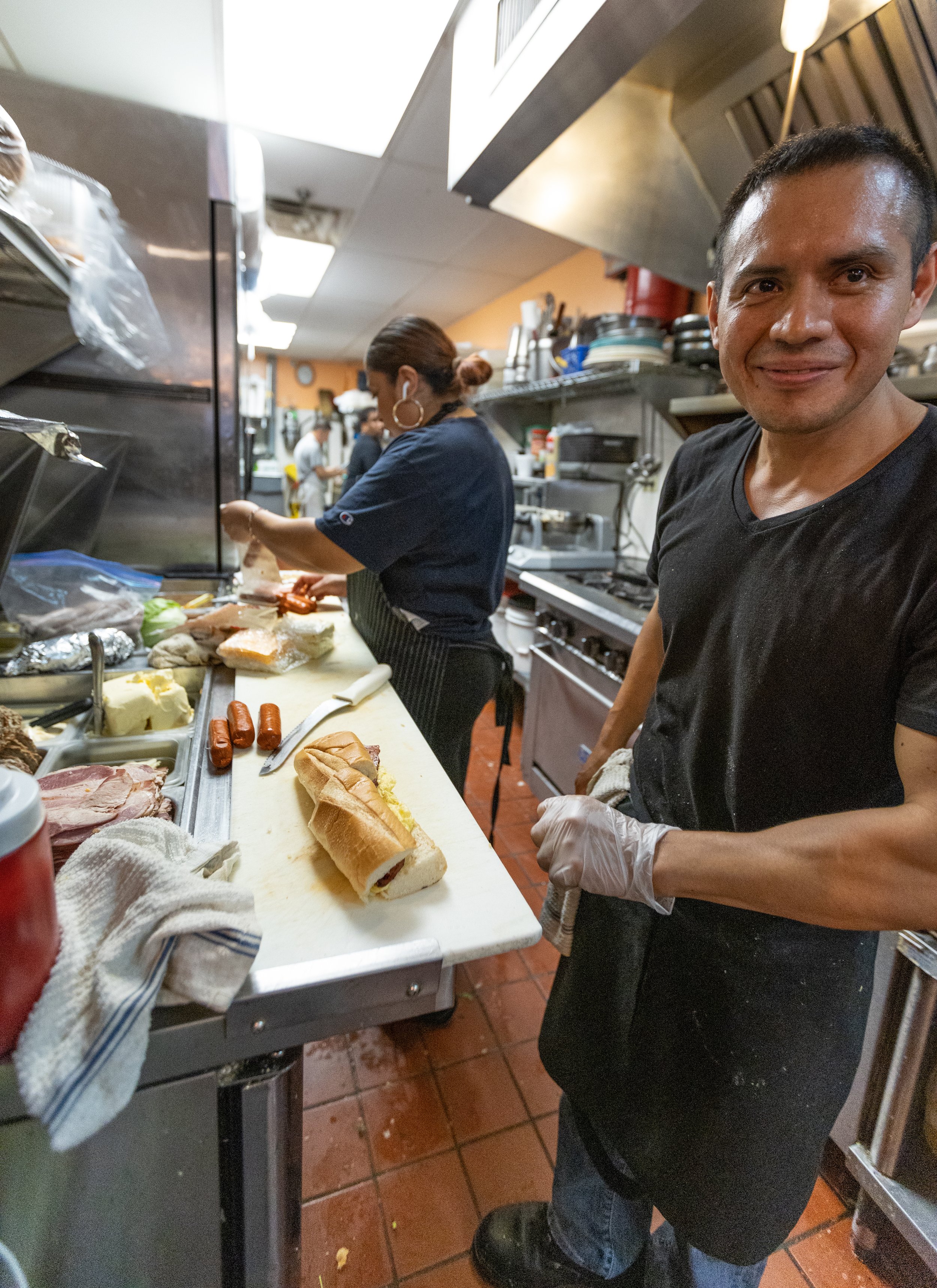
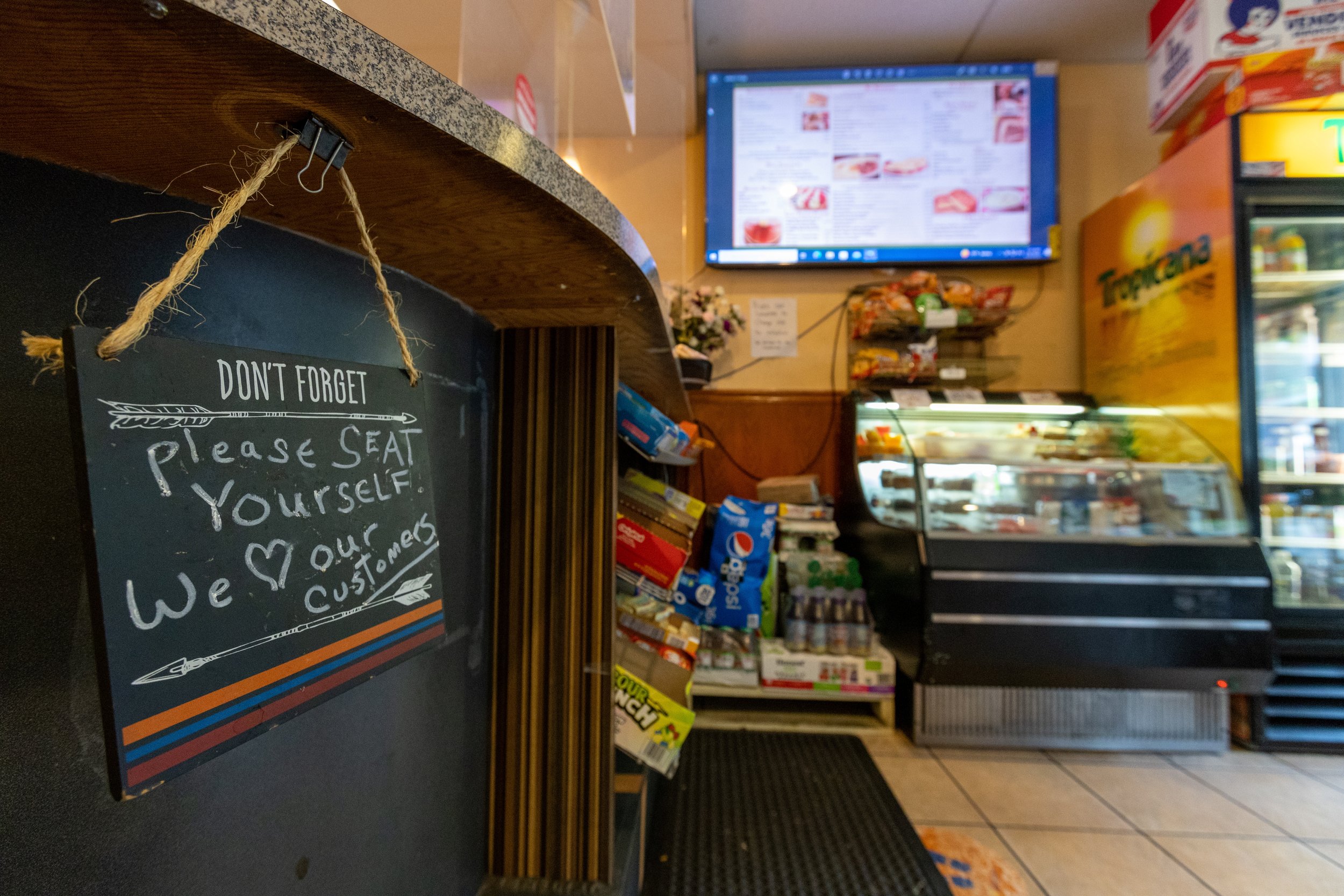
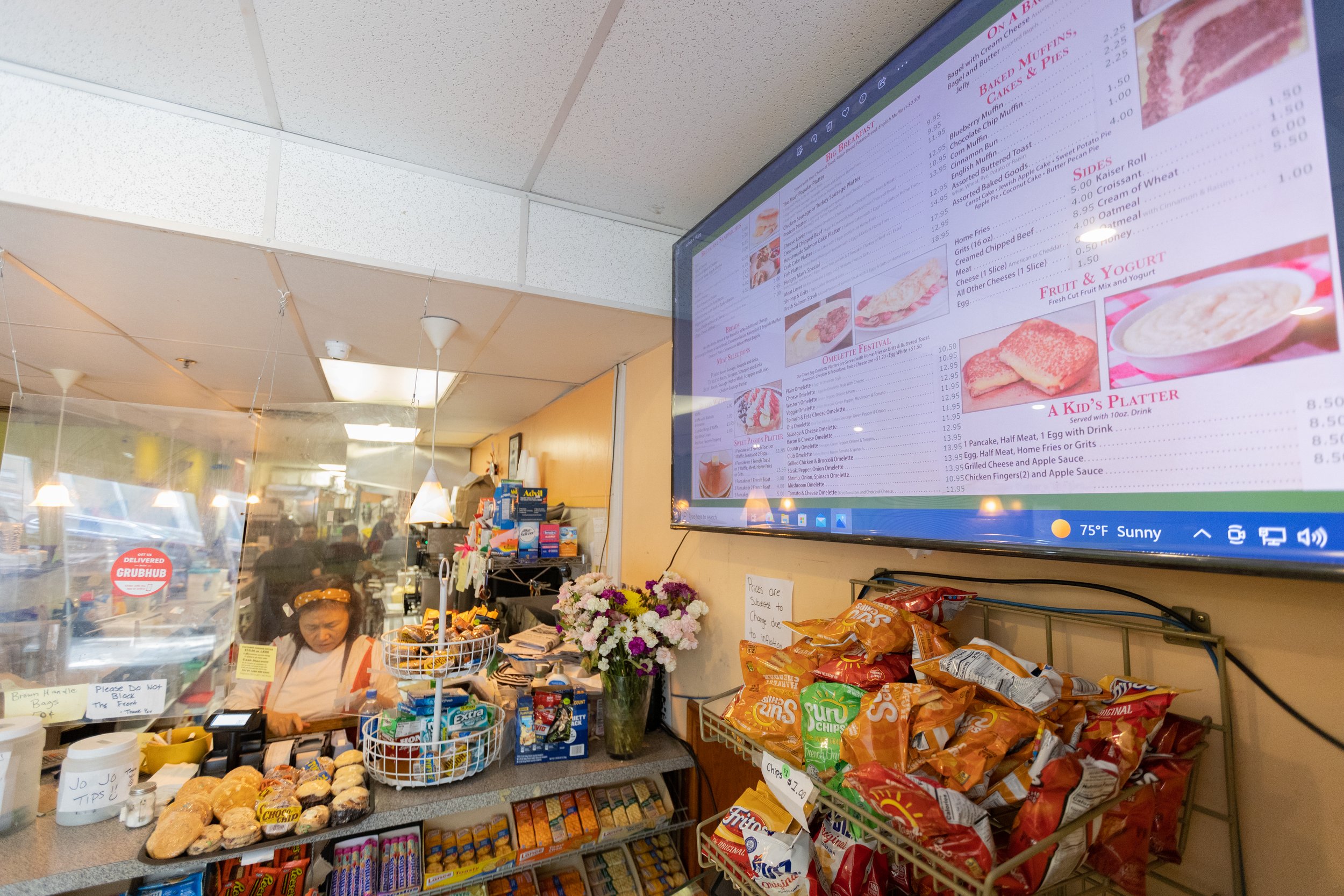
My friend and I sit at a table in the back, and she orders a breakfast sandwich that is gone before I’m halfway through my omelet. “Amazing,” she whispers through a mouth full of bagel and egg, and I feel the same about my omelet.
A perfect amount of feta dances its way across the fresh spinach in my eggs. Onions in my hash browns are preciously crisped around the edges and sweetly gooey everywhere else. I’m reminded I can never seem to make breakfast like this at home.
Owner Minok Kim’s son Dae tells me the secret is in the freshness of ingredients. “My mom’s philosophy is she doesn’t do short cuts. Her way of doing things is labor intensive, but it does ascertain freshness.” A quality that shined through in my omelet—it’s a perspective I appreciate. Kim has a culinary degree from her native Korea and decided to open the luncheonette in 2006 after a friend did the same with some success. Her son Dae has been working almost every position at the luncheonette since that time.
“I started off peeling potatoes, doing dishes–the whole nine–when I was fourteen,” he confides, over a cup of coffee his mother insists on putting in front of me. The business, like most luncheonettes, converted to take-out during COVID-19, but has finally gotten back to near pre-pandemic traffic. I mention the surrounding construction and, now in his thirties, Kim says he’s concerned about the impacts of real estate development on future business.
“Germantown Avenue is going to change by 2025, 2030,” he says, pointing out the window to the cobblestones and trolley tracks. “All seven or eight-story buildings are planned with mixed use ground floor properties, which means a Panera or Wawa could move in to compete with us–the bigger franchise places.”
It concerns him but Kim is committed to being in it for the long haul–or as long as his mother needs him. “I told my mom I would work here until she retires; what’s most important for me and my life is being there for my mom.”
My coffee cup is mostly empty, but as I thank Kim for his time and take my leave, my heart is full, knowing this particular luncheonette is rooted in the kind of mother-son relationship I endeavor to have with my own pancake-consuming child.
Family can be a strong business motivator, as I’ve witnessed. But can it overcome fiscal realities?
“Back in the day,” says Omar Blaik, CEO of U3 Advisors, a real estate and development consultancy in West Philadelphia, “luncheonette owners were families who probably lived in the row houses above or around the lunch counter. But the economics for lunch counters probably don’t work anymore.”
We discuss how fluctuating real estate prices and gentrification have wreaked havoc on so-called mom and pop businesses in modern times; the mural in Blaik’s own lobby pays homage to exactly this. It features a forgotten corner of West Philadelphia’s Black Bottom–a neighborhood razed by commercial developers in the 1960s to make way for the University of Pennsylvania and Drexel. The mural shows customers on the corner waiting for a bus under a sign with an arrow, proclaiming “luncheon.” Blaik’s own U3 sits on 40th Street, in the spot where these Black Bottom businesses thrived decades ago. He keeps the mural “to recognize what the neighborhood was.”
“Now, unless someone gives you cheap space, the cost of food and safety regulations–hoods and fire suppression systems and licensing–make it impossible to put up a kitchen on the cheap.” Gentrification like the process feared by Kim and other business owners, coupled with wildly swinging property values, may help explain why luncheonettes now mostly persist in working class neighborhoods–when they persist at all.
Neighborhoods like the one housing Pete’s Clown House in Frankford, where the coffee is no joke. It is some of the best I’ve had at a luncheonette, strong and punching–just like I need it to be to get through a late-January Wednesday.
Pete’s Clown House, Frankford
“What makes Pete’s is the people. I’m in my sixties, I went to college, ran my own business. I’d still rather work here than retire.”
Make no mistake: Pete’s Clown House isn’t here for the Uber Eats crowd. At the edge of Harrowgate and Juniata, it is here for the neighbors, the regulars. A series of construction trucks make pit stops, parking in front as we wait for our breakfast, grabbing sandwich after sandwich from the counter. Of all the luncheonettes I visit in my journey, Pete’s is consistently hopping.
Sandy Doyle, longtime Pete’s server, hands my friend and I our breakfasts and explains.
“What makes Pete’s is the people,” she says. Doyle shows off a yellow crocheted onesie she made for a friend and customer celebrating the birth of his granddaughter. “I’m in my sixties,” she adds, “I went to college, ran my own business. I’d still rather work here than retire–in fact, I tried to leave after COVID but I came back.”
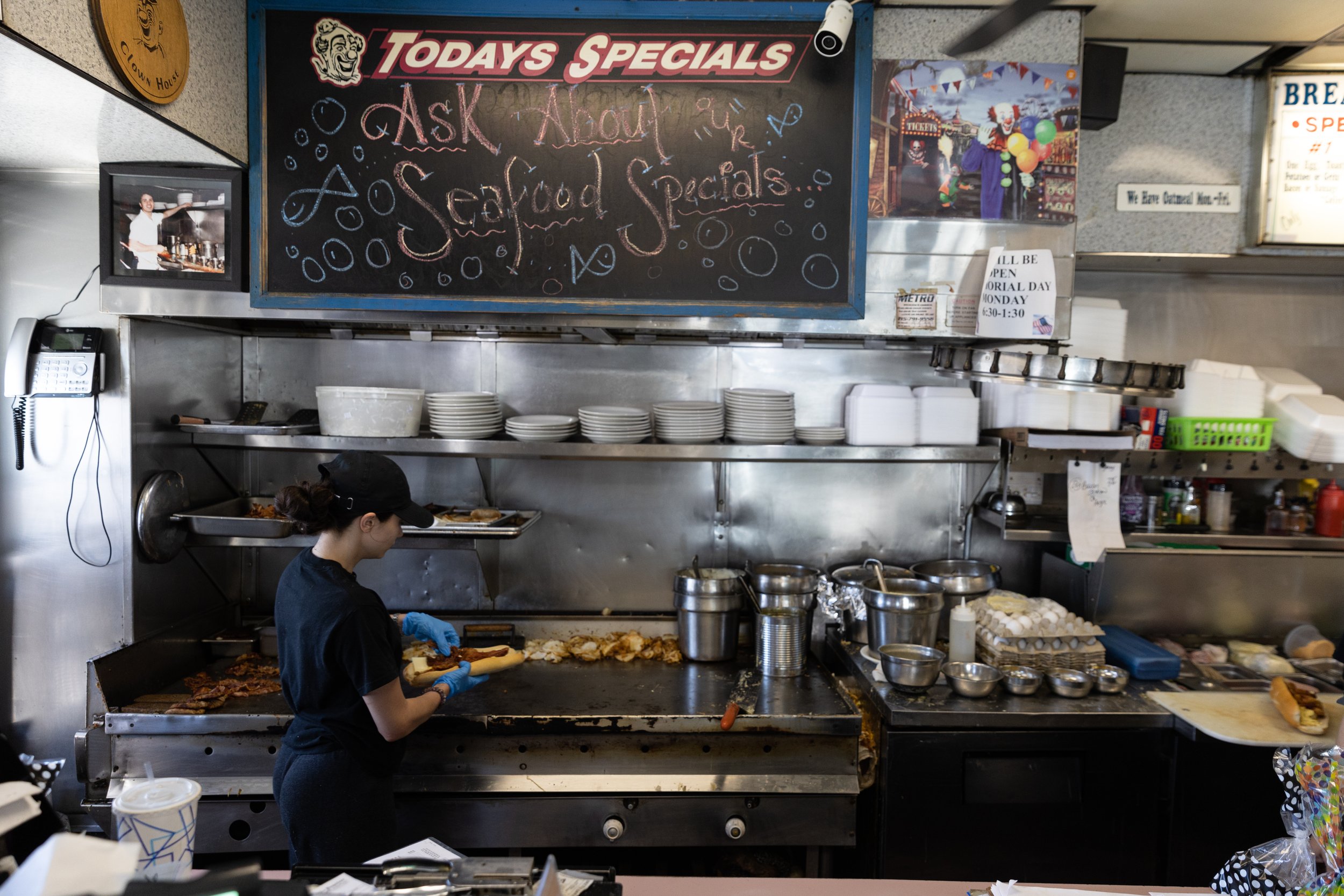

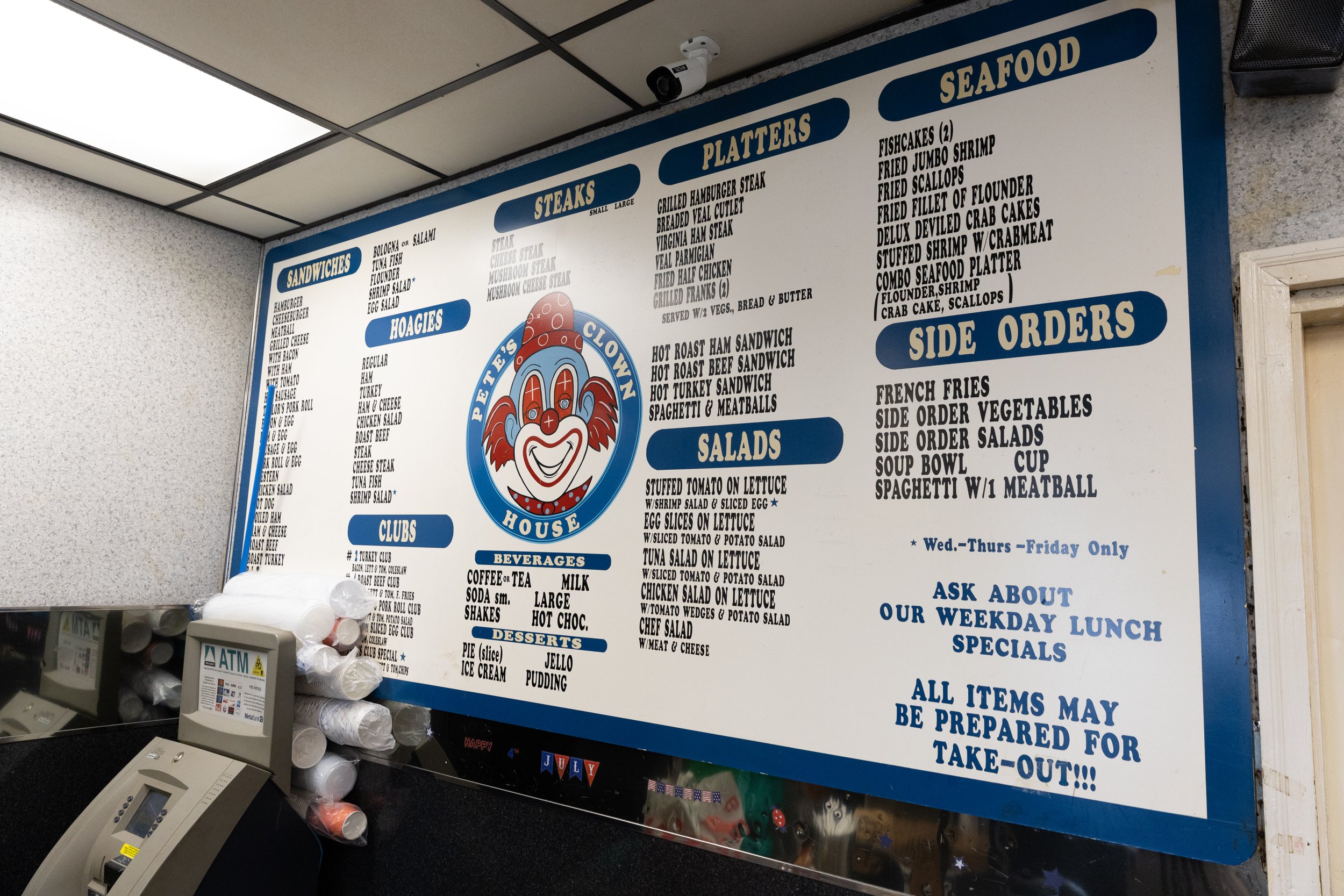
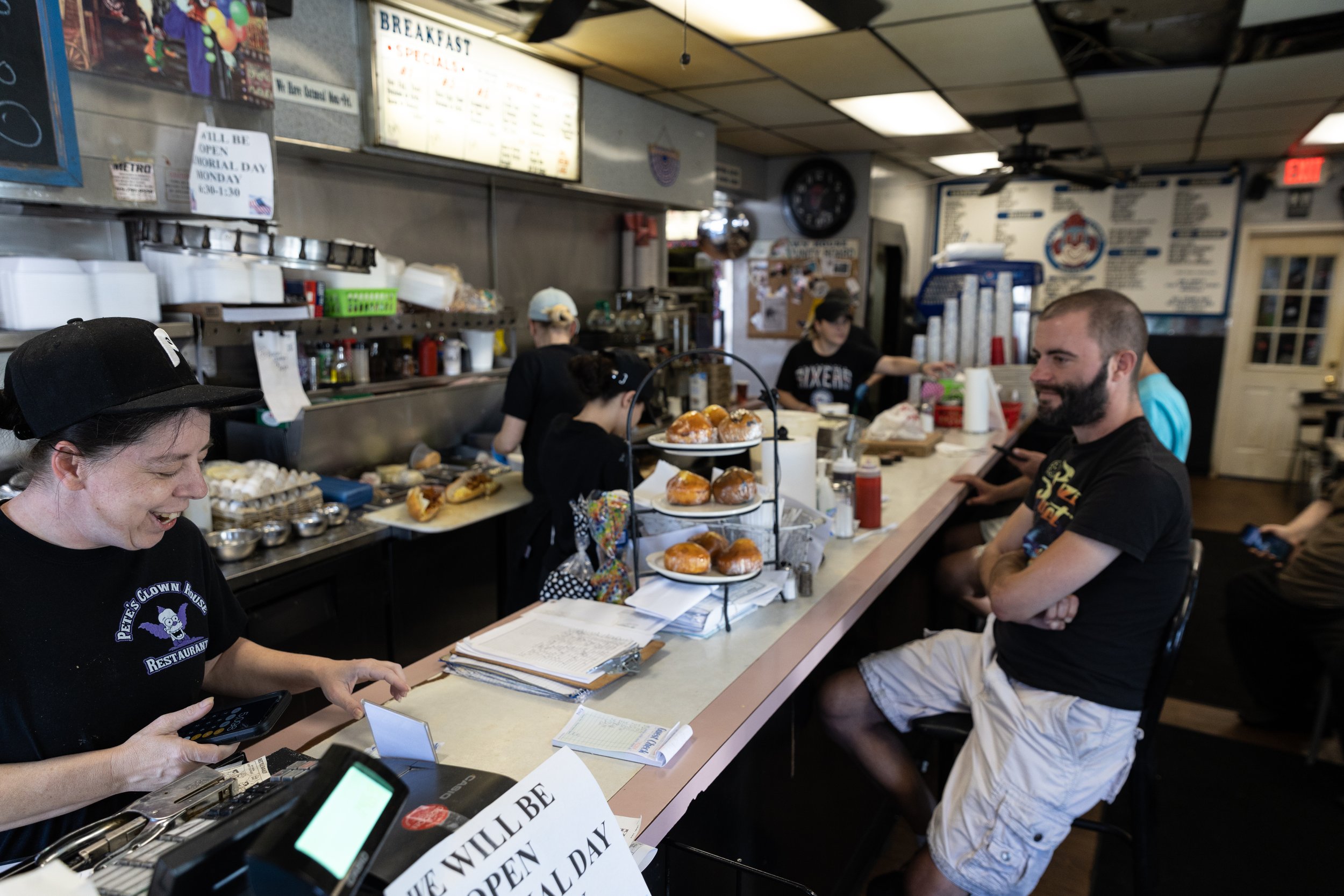
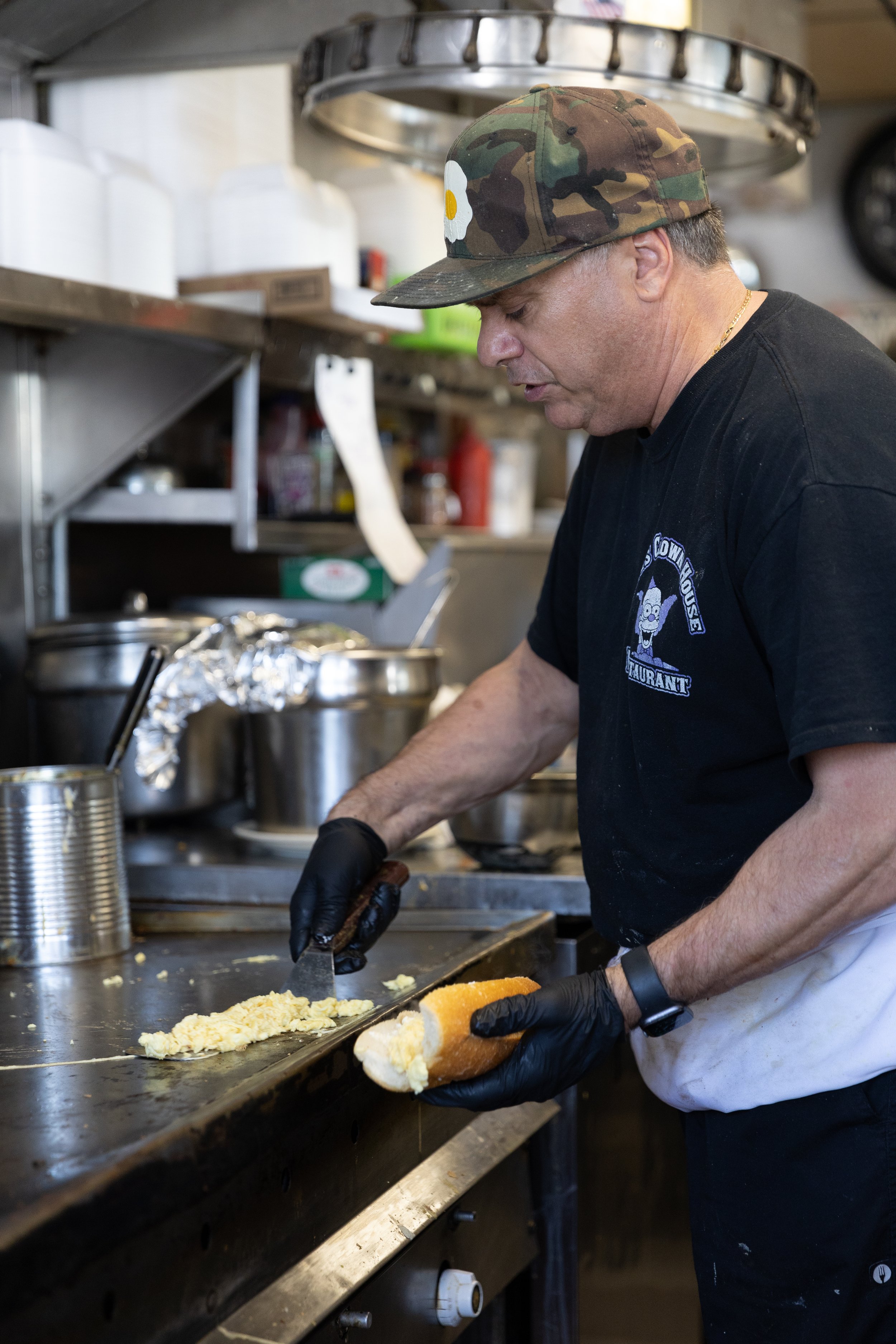
Like most luncheonettes that remain, COVID forced the sit-down model to convert to take out, and a window next to the grill, where Pete’s chef-owner Ronald Bordone doles out home fries, stands as a testament to that moment: a window that serves as a window in time.
At Pete’s, you won’t find anything fancy. In fact, everything is decidedly not fancy, and that’s just fine with the regulars–and with me. My omelet with tomatoes and Swiss is as I need it to be; my friend’s breakfast includes pancakes laced with vanilla and powdered sugar.
“The secret is the vanilla,” Sandy whispers to us. “I even add vanilla myself when I make pancakes at home.” I try this tip days later in my own kitchen, much to the delight of my son. I feel validated, knowing there’s at least one breakfast item I can execute reasonably well on my own at home.
Comfort & Floyd, Passyunk
Still, if we’re keeping score, my favorite breakfast in the city is an omelet made by Bruce Reckahn at Comfort and Floyd on South 11th Street.
Fluffy and rounded, it’s full of succulent, garlic-infused roasted vegetables, nestled in a melty layer of tangy cheddar. The omelet is an expression of the best the luncheonette has to offer: warmth and simplicity. I sit at the counter–a week or so before the Eagles’ spectacular loss in the Super Bowl–and savor it with a strong cup of black coffee, served up by Reckahn’s wife and front-of-house wrangler, Sara.
“This used to be a restaurant called Porto,” she shares–a small, Portuguese-inspired bistro. Old heads, myself included, will remember Comfort and Floyd’s location as the much beloved luncheonette Carman’s Country Kitchen–I won’t recite the restaurant’s bawdy, down-home slogan, though I recall it faithfully every time I hear the name.
Bruce, chef and mastermind of Comfort and Floyd, worked at Carman’s, as well as at the Northern Liberties mainstay, The Abbaye. Moving into a spot previously designated as a luncheonette has done much to help the Reckahns’ Comfort and Floyd stay in business. Similarly, acting as a husband-and-wife team has added labor flexibility.
A native Philadelphian, Sara credits this, government pandemic funding, their manageable rent, and a short, straightforward menu for helping them weather the economic tempests of COVID-19.
“Instead of flying at 10,000 feet with a huge overhead, we tend to fly low to the ground,” she says, mimicking the very apt airplane model of restaurant economics with her hand. Open only Thursday through Monday, 8am-3pm, Reckahn and her husband both work to keep the place moving on a short timeline. “So, when COVID hit, we didn’t crash, we just sort of landed.”
As with the other luncheonettes, Reckahn recalls the shift to take-out during the pandemic, acting as a critical business in a time customers longed for the comforts of normalcy–a need the luncheonette fills with ease. “We’d been in business for less than a year before COVID-19; now that we’re at the tail end of it, we’re looking forward to seeing what a full year of business without the pandemic looks like.”
I nod as she refills my coffee.
“But we made it,” she shrugs with a smile.
As I chase the last caramelized onion around my plate with a roasted potato and bite of marble rye toast, I am grateful they did.
Words by Erica Vanstone
Photos by Kat Veri








